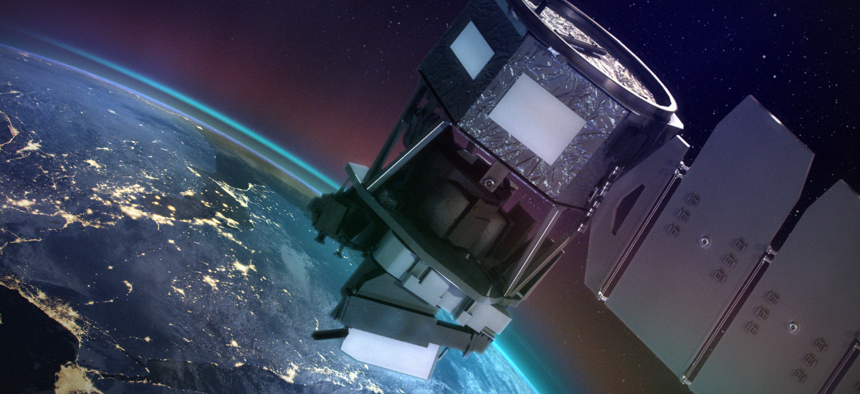What Happens to Astronauts During a Government Shutdown?
How NASA scales down to a skeleton crew when Congress misses a big budget deadline.
As the wheels of the U.S. government ground to a halt Friday at midnight, thousands of federal employees prepared to face days or weeks without work or pay until their offices reopened.
Some employees will continue working through the government shutdown, however, including the three with the longest commute: NASA astronauts Mark Vande Hei, Joseph Acaba, and Scott Tingle. Despite the political tussle that closed most of the government on Saturday, the American part of the International Space Station remains open for business. Mission control staff, considered “essential” personnel, will keep working, too, to support the astronauts.
Phew. And, well, obviously! After all, NASA can’t exactly press pause on the work of keeping humans alive in microgravity 200 miles above Earth, even if Congress missed the deadline for the government running out of money.
“To protect the life of the crew as well as the assets themselves, we would continue to support planned operations of the ISS during any funding hiatus,” states a NASA plan, published in November, that outlines protocols for a potential government shutdown.
In addition to the ISS, NASA will continue with “space launch hardware activities, which are necessary to prevent harm to life or property.” This could mean continuing work on the James Webb Space Telescope, which has undergone months of testing at Johnson Space Center in Houston in preparation for its launch in spring 2019. Satellite missions that are in orbit and operating will keep humming along, while the work on satellite missions that haven’t launched yet would be suspended.
As for staff on the ground, NASA headquarters advises the directors of its various centers around the country on who should keep working and who should stay home. Employees in both categories are furloughed, made to wait for their pay until after Congress approves funding legislation.
The number of employees at all of the agency’s facilities would shrink dramatically. According to a chart included in NASA’s shutdown plan, based on 2015 staffing levels, the workforce at the Goddard Space Flight Center in Maryland, the agency’s largest facility by staff size, the workforce would be reduced from 3,223 to 334. About 193 employees would remain on call in case of emergencies. At Johnson Space Center, a staff of 3,057 would dwindle to 173, with 400 on call.
NASA centers and facilities close to the public, and the agency suspends use of its website and any streaming of its operations online. This means that, if the shutdown continues until next week, a spacewalk outside the ISS scheduled for Tuesday will not be televised.
The shutdown could potentially affect one of the agency’s commercial partners, SpaceX, Elon Musk’s company. SpaceX expects to conduct a major engine test of its Falcon Heavy rocket sometime this weekend at a launchpad at NASA’s Kennedy Space Center in Florida that the company has leased from the agency since 2014. The static-fire test doesn’t require any NASA involvement, but the shutdown may affect staffing and operations in and around the spaceflight center, creating unusual conditions for such a high-stakes procedure. SpaceX has not yet responded to a request for comment on the status of potential testing.
The United Launch Alliance, a joint venture of Lockheed Martin and Boeing—and a SpaceX competitor—got in just under the wire with a launch Friday night from Cape Canaveral Air Force Station in Florida. ULA’s Atlas V rocket carried a surveillance satellite from the U.S. Air Force.
The government shutdown comes on the anniversary of President Trump’s inauguration, and as NASA enters its second year without a permanent administrator. NASA chiefs are chosen by the White House and must be confirmed by the Senate. The Trump administration announced its pick, Oklahoma congressman Jim Bridenstine, last fall, but his nomination has stalled as Democrats and Republicans argue over his credentials and Congress works through a staggering to-do list. This week, after lawmakers failed to break a deadlock over federal protections for young, undocumented immigrants, Senate Democrats and some Republicans responded by blocking a House bill that would buy Congress more time to negotiate a long-term budget deal.
The White House also has yet to nominate a deputy administrator for NASA. Even the chief financial officer who signed recent NASA’s shutdown plan, Andrew Hunter, is serving on an interim basis.
NASA says it takes the agency less than half a day to run through all its shutdown procedures and commence operations with a skeleton crew. Getting the government back up and running again may take much longer than that. The 2013 shutdown, a showdown between former President Barack Obama and Republicans over Obamacare, lasted 16 days, the third-longest in U.S. history. It’s not yet clear what will happen in the next few days. If it’s any comfort, remember that while Washington is at a standstill, the Earth is still spinning, joined in its journey around the sun by three federal employees who won’t stop working.
Sign up for GovExec newsletters and alerts and download our app to stay informed.




